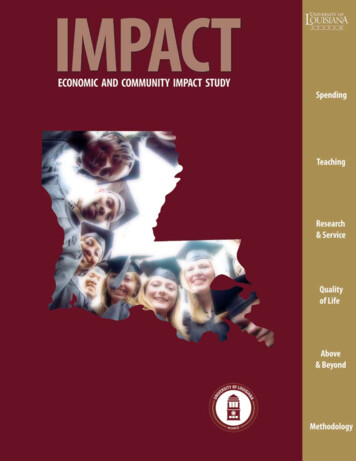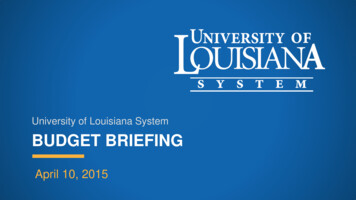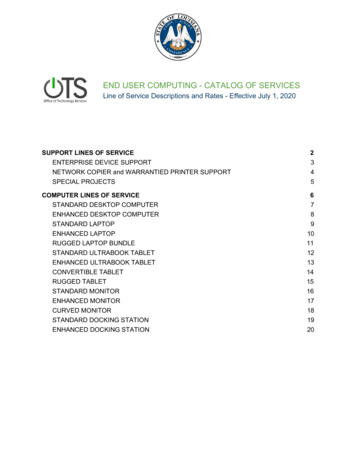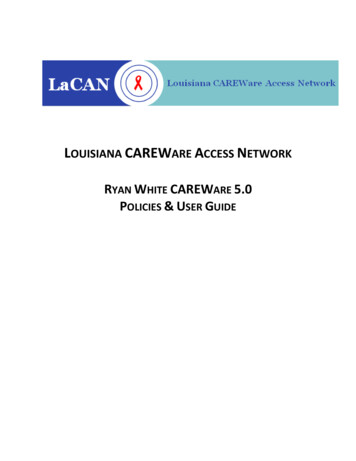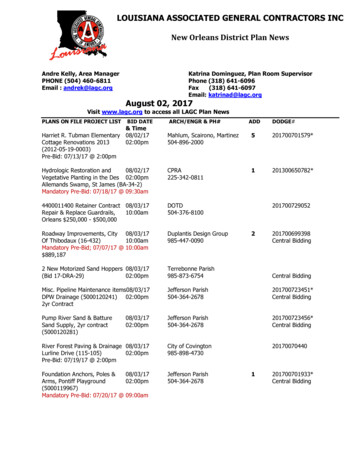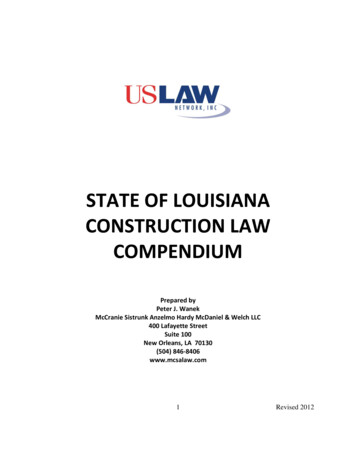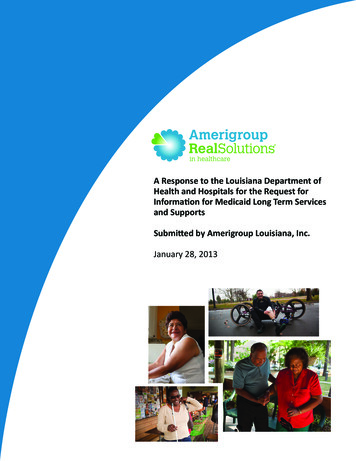
Transcription
A Response to the Louisiana Department ofHealth and Hospitals for the Request forInformation for Medicaid Long Term Servicesand SupportsSubmitted by Amerigroup Louisiana, Inc.January 28, 2013
This page is intentionally left blank
This page is intentionally left blank
Louisiana Medicaid Long Term Services andSupports RFI ResponseIntroductionAmerigroup Louisiana is enthusiastic and supportive of DHH’s request to seek information andrecommendations toward building a Managed Medicaid Long‐Term Services and Supports (LTSS)program. We, along with Amerigroup Corporation and our parent company, WellPoint, are a leader inMedicaid program management. We’re also a leader in providing LTSS to member populations, withmore than 15,000 members who currently receive LTSS services. We establish and maintain a disciplinedapproach to caring for those most in need of care and services.With this RFI, we will show that we have the experience and knowledge to make recommendations andpartner with DHH to help redesign the current Medicaid program. We will address DHH’s unique needswhile presenting Louisianans with quality healthcare options.Experience in MedicaidAmerigroup Louisiana currently serves 144,000 members through Medicaid, Louisiana Children’s HealthInsurance Program (CHIP), Temporary Assistance for Needy Families (TANF), and the SupplementalSecurity Income/Aged, Blind and Disabled (SSI/ABD) programs. Therefore, we have the establishedrelationships and local knowledge to quickly and efficiently expand our programs while drawing on bestpractices from affiliate experience with LTSS program design. Also, we are a leader in Medicaid and long‐term care program management. With approximately 4.6 million TANF, CHIP, SSI, and LTSS membersnationally that represent low‐income families, children, pregnant women, seniors and people withdisabilities, our programs reflect our knowledge of what works, what matters, and what best servesmembers and the goals of the states we assist. A breakdown of the populations we serve by state isillustrated in Figure 1.Louisiana Medicaid Long Term Services and Supports RFI ResponseJanuary 28, 2013Page 1 of 14
Figure 1. WellPoint/Amerigroup Health Plans Provide Services to Approximately 4.6 Million MembersNationallyOur members are empowered by our programs because we design the programs to help maintain andimprove our members’ health and address and step beyond barriers surrounding poverty.Since more than 15,000 of our members qualify for both Medicaid and Medicare and/or require LTSS,we see this as an area of great opportunity for coordination of care and cost efficiencies. Thesemembers are a unique population and have a distinguishing set of characteristics. They can have highrates of chronic illness or can suffer multiple chronic illnessesthat make treatment and services much more complicated –meaning they can sometimes need specialized health careservices, which generally represents the highest costs forstate programs. Consequently, this population represents anarea of great opportunity — to streamline programs andreduce duplication via service coordination.No matter the barriers or challenges, we design programsthat surround each member with holistic care, embeddingcompassion, dignity, and empathy into our member‐providerrelationships that nurture and help create more positiveoutcomes for all. Our programs also emphasize theopportunity for our members to live independentlywhenever possible either in their own home or within thecommunity.Louisiana Medicaid Long Term Services and Supports RFI ResponseJanuary 28, 2013Page 2 of 14
Populations and Program DesignIn order to create a program that best addresses the needs of the members while being efficient andcost‐effective, we recommend that both the Medicaid and dual‐eligible (Medicare and Medicaid)populations be served under a full‐risk, mandatory enrollment, which would transfer all of the healthcare delivery risk to the contracted MCOs. We also recommend selecting the most qualified MCOsthrough a competitive request for proposal (RFP process). This is the approach that will result in a plan’sability to manage across the full spectrum of benefits and services and will reduce the unnecessarysegmentation of health care services; a better, more holistic approach for the member. In turn, thisapproach also allows for the highest quality, most sustainable design. Benefits and services shouldinclude acute, long‐term services and supports, and nursing facility services. And, while all services mustbe supported by the premium, below are suggested services for this population:Table 1. A Blend of Acute Services and Long-Term Services and Supports is Recommended Acute Health ServicesHospitalinpatient/outpatientBehavioral healthinpatient/outpatientSkilled nursingRehab therapies (includingphysical, occupational,speech/language)Outpatient diagnosticLaboratoryProfessional servicesAmbulanceEmergency roomHome healthHospice (through FFS)Transplant servicesPharmacy (including Part D)Long‐Term Services and Supports Adaptive aids Adult foster care Assisted living/residentialcare Personal emergencyresponse System Supplies and DME Home modifications Nursing services Home therapy Respite care Personal assistance services Day activity program Long‐term nursing facility OtherService coordinationNon‐emergencytransportationRoutine dentalWeight loss programsSmoking cessationFinancial counselingHome‐delivered mealsIn‐home monitoringsystemThe most effective, efficient approach is one rooted in comprehensive, consistent care, maximizingmembers’ independence, and valuing individuals’ preferences and personal choice. Whether themember needs acute care and help coordinating benefits and services or whether he or she needs a fullrange of both acute and community‐based services and aid for caregivers, one plan can coordinate theexperience required and the support needed.It also drives significant cost savings for DHH while creating more satisfied consumers and improvedhealth outcomes. Generally for those who meet the requirements for nursing facility level of care, thistype of individualized managed care costs approximately one‐third that of nursing facility care.Louisiana Medicaid Long Term Services and Supports RFI ResponseJanuary 28, 2013Page 3 of 14
Components of a Results-oriented ApproachCreating a synergistic, cost‐effective healthcare model for members receiving LTSS services requiresprograms that smoothly dovetail with one another. Providers and service coordinators must be able toreceive and communicate current, accurate information, and the information from assessments must beable to support both positive health outcomes and the members’ health and DHH’s goals. In order tobuild an approach that serves these needs, we recommend that DHH seek out partners who haveexperience in the following: Engaging Providers — To help ensure measureable improvement in the health care status ofmembers, MCOs should develop a plan to deliver results. Provider engagement strategies thatinclude incentive for delivery of care and related services, collaboration of community‐ andfaith‐based providers, and ongoing education and materials equip providers with the necessarytools to affect health outcomes. Conducting Assessments — To help assure that members have the full range of services theyneed, MCOs should start with a comprehensive assessment that reviews the physical, cognitive,environmental, social, functional (how well one is able to move about or complete the activitiesof daily living), and behavioral health aspects of the member. They should also focus on theneeds and strengths of the individual and/or family members/caregivers. This record is multi‐dimensional and includes member demographics, comprehensive information on the member’sgoals, capacities, and physical and behavioral health conditions. Developing a Comprehensive Plan — Using information from the assessment, MCOs shouldestablish a member‐centered plan that meets the member’s needs and goals. The processshould include the member, providers and family/caregiver/legal guardian when needed soMCOs can outline and authorize all necessary services. This plan should identify both naturalsupports and contracted providers. Most importantly, the plan’s goals and objectives reflect themember preferences of services, supports and providers. Providing Service Coordination — Service coordination is the central, ongoing management ofthe diverse aspects of member care throughout the acute and post‐acute healthcare continuumto achieve the highest quality and most cost‐effective outcomes. Service coordination engagesmembers and their families (when needed) in the development of a specific member plan forcare, a specific individual service plan, and links the members and their families to other healthcare and/or services that address the full range of their needs and concerns. Through thisprocess, MCOs should capitalize on existing resources within communities and help assure thatmembers and their families are linked to both formal and informal supports. Servicecoordinators are the “system navigators” for members and their families and help ensure thatmembers have all the information they need to make personal choices about their care. Providing Transitional Care Management — Members are at greater risk when their situationor healthcare changes. For this reason, MCOs should use algorithms to identify and monitorcritical factors that could indicate a change and manage the inevitable transitions that occur.Louisiana Medicaid Long Term Services and Supports RFI ResponseJanuary 28, 2013Page 4 of 14
Transitional Care Management methods should view transitional care as a set of actionsdesigned to ensure the coordination and continuity of healthcare as members transfer betweendifferent locations or different levels of care within the same location (for example: hospitals,sub‐acute and post‐acute nursing facilities, the member’s home, primary and specialty careoffices, assisted living and nursing facilities).Best PracticesDHH should develop a collaborative model with the MCO that facilitates the sharing of best practicesacross plans. This will enable the plan to work with DHH on elements such as quality metrics, partneringwith providers, enhancing cultural competency among providers, and designing mechanisms to helpengage and educate stakeholders and members. We have and continue to develop best practices thatovercome barriers to high quality services and supports, take advantage of opportunities to createsynergies, and create cross‐walks from one aspect of care to another amongother things. And they are reflective of the approach we take every day withour members — to offer the best care possible, with the most efficiencypossible while creating cost savings for DHH. Below are a few examples ofour best practices:Health Homes/Patient Centered Medical Homes. Since the late 1960s, theconcept of the medical or patient‐centered medical home has gained support and acceptance as a wayto offer members a team of healthcare professionals who provide a single source of comprehensive,continuous care. This allows patients to receive higher quality care. Often, the care team is led by themembers’ PCP. By tailoring health homes to meet individual needs, MCOs can help members: With multiple chronic medical conditions benefit from a medical home led by a primary careprovider (PCP) With a severe and persistent mental illness who might require a health home supported by apsychiatrist or psychologist to supplement the PCP relationship Who are homebound and need the support of a health home staffed with personnelexperienced with long‐term services and supports that can optimize the member’s level offunctioning and independenceCreating a flexible model helps members with multiple chronic illnesses receivethe combination of care that most benefits their healthcare needs. Anotherbenefit of health homes is matching funding. When properly engaged, thiseffort can essentially garner DHH more money by gaining up to a 90 percentfederal funding match. DHH can use those dollars to coordinate and betterintegrate primary, acute, behavioral health, and long‐term services andsupports for members enrolled in health homes.Louisiana Medicaid Long Term Services and Supports RFI ResponseJanuary 28, 2013Page 5 of 14
In 2011, Amerigroup Georgia developed health homes with the goal of helping members with diabetesand heart conditions better manage their conditions. After the program’s first nine months, 100 percentof Amerigroup Georgia’s health home members reported they were more confident in their ability tomanage their condition in collaboration with the home health physician. Company‐wide there havebeen similar successes.Predictive Modeling. Informed by significant experience in programming for vulnerable, complex, andhigh‐cost populations such as those needing long‐term services and supports, Amerigroup hasdeveloped active and ongoing predictive modeling technologies and personnel to help support targeted,appropriate case management approaches. This helps us attain a very high predictability rate ofproactively identifying individuals at risk for hospitalization or institutionalization. Focusing first on thesecases, which typically include LTSS and dual‐eligible members, will help focus the system on its mostvulnerable and most costly.Provider Partnering. Amerigroup is a strong proponent of partnering with providers in a variety of ways,including the creation of Amerigroup‐supported medical home initiatives, provider incentive programs,and shared‐performance programs, which have been embraced by our provider community. Usingadvanced, high‐level technologies is a linchpin for success in these types of partnerships. MCOs need todiscuss and receive informed input and direction from DHH on what types of partnering with what typesof providers would be most consistent with their vision.Interdisciplinary Care Team. An interdisciplinary Care Team should develop individualized and holisticcare/service plans with member, caregiver, and family member input to meet the needs of the member.This multi‐member team should consist of clinicians with experience in areas determined by themember’s needs. The case manager in conjunction with the interdisciplinary team should analyze andincorporate member health information to identify specific treatment. The team should then developand update individual care plans; manage the member’s care; and communicate, coordinate, andmonitor execution of all elements of the care/service plan.Individualized Care/Service Plans. A best‐in‐class health risk assessment tool that measures all aspectsof a member’s physical health, behavioral health, social needs, level of functioning, and environmentalconditions should form the foundation of the service/care management model. Initial assessmentsshould involve standardized, electronic, comprehensive assessments of the individual’s goals; physical,cognitive, social, environmental, and behavioral health conditions; and needs and strengths of theindividual, family, and/or caregiver. This assessment information can then be used to develop a roadmap to formulate a plan from which to better care for members who require more individualized healthcare.Transitional Care. MCOs should have a defined action plan designed to ensure the coordination andcontinuity of care and services when individuals transfer among different locations (such as hospitals,sub‐acute, and post‐acute nursing facilities; the individual’s home; physician offices; assisted living; andnursing facilities) or different levels of care within the same location. This comprehensive plan shouldLouisiana Medicaid Long Term Services and Supports RFI ResponseJanuary 28, 2013Page 6 of 14
take into account the individual’s goals, preferences, and clinical status, and it should focus on individualand family education and coordination among the health professionals involved in the transition. Theplan should include logistical arrangements such as transportation and respite care; individual educationregarding disease states; frequent individual interaction with the case manager and other members ofthe care team; and education. Housing issues are among the biggest concerns for people who aretransitioning from a nursing facility back into the community.Quality Management/Measurements. In addition to traditional acute care quality measures, a qualityprogram for this population should include measures such as program efficiency in containing costs;optimizing community inclusion; client access to services; client centered service planning and delivery;provider access and capabilities; client safety, outcomes, satisfaction, and well‐being; emergency roomutilization; nursing home admissions; and acute hospital and nursing home readmissions.The Amerigroup Quality Management (QM) program is fully integrated and encompasses the fullspectrum of physical and behavioral health services, including LTSS. We currently provide direct QMoversight of LTSS at our health plans in several states. Amerigroup has the expertise to collect accuratedata and competently evaluate measures. Therefore, we propose a collaborative relationship with theState to develop meaningful performance measures that could include: Member eligibility and use of services Cost A focus on functional status measuresIntegrating Behavioral HealthcareAmerigroup has vast experience with providing seniors and persons with disabilities (SPD) and dual‐eligible members with needed care and validates that both segments of the population — seniors andpersons with disabilities — have higher rates of co‐morbid physical and behavioral health conditions.We acknowledge and respect the DHH’s established relationship with Magellan Behavioral Health aspart of the Louisiana Behavioral Health Partnership. We also understand and appreciate the desire toinclude this partnership in any Behavioral Health (BH) model moving forward as it seems to offer aplatform from which to continue to build BH benefits and services. However, we believe that having twodifferent organizations providing BH care to members fragments the care they receive.Therefore, we strongly support the integration of physical and behavioral health services because it isa cornerstone of any program designed to effectively manage this population. Additionally, since wealready provide basic BH benefits and services to members as well as the more subtle BH servicesprovided by the member’s PCP or medical office through routine medical evaluations, shifting inpatientacute psychiatric services currently carved‐out would, for us, be a seamless transition for members. Wealready successfully use this approach in most of our other affiliate state health plans.Louisiana Medicaid Long Term Services and Supports RFI ResponseJanuary 28, 2013Page 7 of 14
In state procurements for MCO participation in an integrated program for SPD members, werecommend that DHH evaluate applicants, in part, based on their ability to integrate physical andbehavioral health in day‐to‐day care management. Successful MCOs should have in‐house behavioralhealth expertise. They should be a supportive partner for the agency and other stakeholders. Theyshould have experience with an integrated case management program based on predictive modelingand risk stratification of both medical and behavioral conditions that combines physical and behavioralhealth data into ongoing care management.Other desirable capabilities include co‐rounding with both psychiatrists and physical health physicians;and training and coordination programs that pair primary care practitioners and behavioral healthclinicians. These kinds of capabilities ensure a truly integrated approach that can optimize treatmentand promote continuity of care. It is key for optimal clinical outcomes to manage the individual person,not just the person’s primary medical condition. An integrated program that recognizes how behavioral,social, and functional challenges can compromise an individual’s overall health status (especially inlow‐income populations) is paramount to delivering improved health outcomes to this population.Members are Individuals with Unique NeedsEmbedding Cultural CompetencyDHH should expect MCOs to offer plans that have a highly developed cultural competency program. Itshould include a wide range of activities that reduce health disparities and provide meaningful services.They must make sure MCOs understand the importance of cultural norms because it is essential toensuring members live more successfully in the community.This helps create an environment that is understanding and sensitive to welcoming and includingmembers in their healthcare and services. It encourages members to fully employ the services offeredso they can receive the healthcare and supports they need to reach their personal health and life goals,reinforcing member‐centered and self‐directed services. In this way, cultural competency becomes acomprehensive, effective tool to address health disparities among members by engaging members earlyand often. In particular, this approach supports embracing cultural beliefs, preferences, expectations,and norms that influence how and where members access healthcare services and engage with theirservice and care providers. Focusing on this also helps ensure that members are able to receive, read,and understand healthcare information and member‐directed healthcare education aiding them ineffectively interacting with their providers.A broad approach to cultural competency will help embed cultural responsiveness in all practices andcustomer interactions. Specific requirements to govern such activities should include: Developing and managing provider training, networks, and services Developing and maintaining a diverse employee workforce Developing and implementing care, service delivery, and management programs Developing and implementing member and provider outreach and education programsLouisiana Medicaid Long Term Services and Supports RFI ResponseJanuary 28, 2013Page 8 of 14
Developing, implementing, and maintaining specific cultural requirements Developing and maintaining locations where services can be accessed Developing and maintaining how members will be educated about cultural competencyTo ensure local representation, a local committee/organization can be appointed to guarantee: Provider network diversity Workforce diversity Cultural competency training Member outreach and educationTo determine the effectiveness of a cultural competency program, DHH can closely monitor membercomplaints and member satisfaction surveys. And, to make sure the program is in line with DHH goals,policies and procedures can be established and revised as often as the agency deems necessary.Service Coordination/Case ManagementEnsuring conflict‐free case management should be another tenet of any holistic member‐centeredapproach to care. We advocate that the MCO manage the case management/service coordinationservices rather than a third‐party vendor or agency. We believe allowing an MCO to oversee theseservices creates a far more holistic approach. Plans can be created by a case manager/servicecoordinator who knows the member and his or her needs and goals, as this manager has access to thewhole spectrum of the member’s care and can make care decisions based on that knowledge. Themember and case manager are also matched as closely as possible on cultural similarities. Casemanagement/service coordination also allows the MCO to better manage the payment process thushelping ensure that the responsible payer (either Medicaid or Medicare, depending on the servicesreceived) is properly billed and reimburses the correct payment for the services rendered. To furthersafeguard members and DHH, MCOs should not work with any provider who also provides either casemanagement, or functional eligibility assessments as outlined by the Affordable Care Act.Education and OutreachA strong education and outreach plan is critical to the success of an integrated program for membersreceiving LTSS services and dual‐eligible members. We recommend both populations be included andan integrated program be created that will involve new ways of delivering services for thesepopulations. DHH should plan to prepare the various stakeholders using a variety of education methodsand forums. The DHH can also include any lessons learned from its experience with other waivers andLTSS programs and incorporate them into the overall outreach plan for maximum effect.Educating individuals about the program should be done through anumber of channels, including local, grassroots efforts throughstakeholder involvement. DHH should employ local county social servicesoffices, newspapers and radio, online web‐based information, and directLouisiana Medicaid Long Term Services and Supports RFI ResponseJanuary 28, 2013Page 9 of 14
mail prior to implementation so all media can promote the details of the program in all pertinentlanguages. This multi‐channel approach will help ensure that information reaches individuals withlimited access to transportation and/or technology. At roll‐out, the agency, in conjunction with theMCOs, should organize informational and enrollment events on all levels, promotional mailings andeducational forums for enrollees to learn about the program, their health plan choices, and how theenrollment process will work.In each parish in the program service area, DHH should identify key stakeholders and hold meetings toeducate and explain to them how the program will work. This will allow the agency to present its visionfor the program and permit stakeholders to ask questions and get answers from agency officials. Specialemphasis should be placed on provider meetings to educate the various provider groups, includingdoctors, hospitals, home health providers, nursing facilities, and community‐ and faith‐based LTSSproviders. The agency should also have town hall meetings to inform individuals, consumer advocacygroups, and organizations about the new program and how to enroll. We recommend that DHHcontinue stakeholder meetings through the first year of the program to ensure ongoing communicationsand education. This also gives stakeholders and interested parties an opportunity to provide feedback. Itmay even be helpful to establish regional advisory committees to perform this function through aformalized structure.Ongoing community and stakeholder engagement will be important to program’s success and in keepingconstituents informed on progress. The agency also should consider contracting with community‐ andfaith‐based organizations to assist and supplement its community outreach and educational efforts.Such groups might include: New Orleans/Baton Rouge Speech andHearing CenterSouthwest Louisiana IndependenceCenter United Cerebral Palsy of Greater NewOrleans Southern Care Alzheimer’s Services of the Capital Area Calcasieu for Retarded Citizens Epilepsy Foundation of Louisiana Point Coupe and Iberville Councils onAging NAMI Louisiana Resources for Independent Living Deaf Action Center of LA Advocacy Center OPTIONS Kingsley House New Horizons Catholic Charities PACE Centers for Independent Living Louisiana Medicaid Long Term Services and Supports RFI ResponseJanuary 28, 2013Page 10 of 14
It is also essential that providers and stakeholders, particularly nursing facilities, be involved in buildingthe parameters of the program. This is a great opportunity to fully engage and build a solid relationshipwith these providers and work with them as resource partners. This will help create depth andsustainability and help construct a sturdy, long‐term, collaborative investment in DHH and this program.While this won’t happen overnight, we will be there to help develop a program that will serve all itsmembers within the agency’s financial parameters. This approach will provide the agency and itsindividuals a sustainable, financially sound, expandable program.Prior to ImplementationThese community and stakeholder relationships should be established early during program design andmaintained throughout the duration of the contract to continually provide oversight and monitoring ofthe program. A good example of engaging stakeholders early in the development of a new program isthe Tennessee CHOICES program. During the initial stakeholder process, the state TennCare programexamined a variety of LTSS delivery system options to achieve its overall goal of improving access andchoices for individuals needing LTSS. State staff worked with existing MCOs providing managed acutecare services through the TennCare program, as well as other stakeholders, to design a program thateffectively diverts nursing home placement to an expanded HCBS program. Stakeholders help buildstrong member protections in the CHOICES program. Tennessee is one of the few states with experiencein integrating all services, including behavioral health, into managed care.Another essential element of effective program design is assuring collaboration and engagement of theprovider community. It is in the intersection of quality and cost improvement where DHH can realize themaximum benefits of an integrated program for LTSS members, as well as participating providers andDHH. Through effective provider collaboration, national MCOs with experience managing integratedprograms in other states can deploy the experience gained in other markets to bring tested, bestpractices to positively affect the transformation of healthcare delivery.Louisiana Medicaid Long Term Services and Supports RFI ResponseJanuary 28, 2013Page 11 of 14
Initial TimeframeThe initial timeframe for this program is approximately 10 months from inception to go‐live. AmerigroupLouisiana is able to provide this condensed ramp up be
Amerigroup Louisiana currently serves 144,000 members through Medicaid, Louisiana Children’s Health Insurance Program (CHIP), Temporary Assistance for Needy Families (TANF), and the Supplemental . Routine dental . offic



